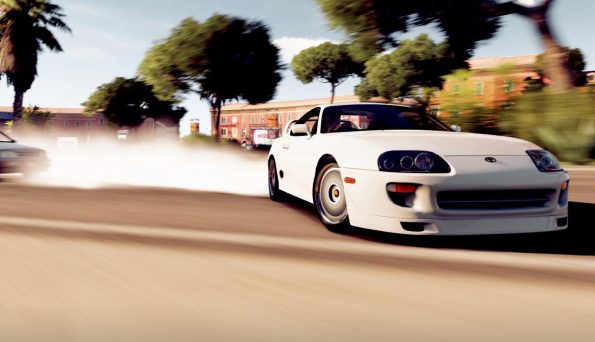A skid is when your tyres lose traction with the surface they are on. Whenever you drive your vehicle your tyres are subjected to forces that try to make them skid:
- Acceleration – your wheels will try to spin
- Braking – your wheels will try to lock up
- Turning – your wheels will try to slide sideways
- Standing water – your wheels will try to ride up on top of the water
You won’t skid every time you accelerate, brake, steer or drive on standing water, so skidding is caused by driving in excess of what the conditions allow and performing a manoeuvre or action that exceeds the friction on the road.
Your vehicle’s tendency to skid depends on:
- Its weight – heavier vehicles take more energy to turn, stop and accelerate
- How wide its tyres are – wider tyres generally mean more contact with the road and therefore more grip
- How good its suspension is – good suspension keeps the weight distribution more balanced, improving braking
- Whether the tyres are at the correct pressures – over-inflated tyres have less contact with the road whereas under-inflated tyres deform easily under pressure (see this article about looking after your tyres)
- Whether it has anti-lock brakes – these detect a skid and release the brakes
- Whether it has traction control – these detect wheelspin and restrict the throttle
- How fast you attempt to turn – trying to change direction places sideways momentum on the car, and you can easily overcome friction
- How soft the tyres are – softer tyres tend to have more grip because they trade rubber with the road
- How much tread the tyres have – tyres with better tread can disperse standing water more effectively
- How slippery the surface is – the surface is affected by water, gravel, ice, snow, oil, dust and more.
As you can see, there are a lot of things to think about.
Oversteer
Oversteer is where the rear wheels break traction before the front wheels and the back end of the vehicle will slide out towards the outside of the turn. This is used to effect in the sports of drifting and speedway.

To correct oversteer you must turn towards the direction of the skid (opposite lock). It’s easy to over-correct and end up spinning the other way.
Understeer
Understeer is easier to control, usually all that’s required is to lift off the throttle. Braking often will make it worse. It’s where you turn the wheels but the vehicle wants to carry on going forwards. It’s caused by entering the corner too fast or applying too much acceleration in a corner. In a front-wheel drive vehicle, wheelspin will cause understeer; in a rear-wheel drive vehicle it can ‘push understeer’ where the rear wheels push the front wheels straight.
Understeer is common on snow and ice.
This video explains understeer and oversteer in a Formula 1 car.
Aquaplaning or hydroplaning
Aquaplaning is where your tyres’ tread can’t disperse water quickly enough and the tyre rides up on the water’s surface. At this point you will have very little grip. To regain grip, back off the throttle, keep a firm grip on the steering wheel and try to keep the wheels straight. If you start sliding, turn towards the direction of the skid.
If you hit deep water then this exerts a drag on your vehicle. If it’s just one side, then it’ll cause you to turn towards that side, and the slippery road will mean you’re likely to spin. You can see it in this video.
Wheelspin
Wheelspin is where the engine is trying to turn the wheels faster than the grip of the road allows. It’s used in burnouts in drag racing to heat up the tyres. You can see in this slow motion video how the tyre breaks contact with the tarmac and then vapourises the rubber
Four-wheel drift
A four-wheel drift is when the vehicle has good balance and the front and back wheels slide equally. It is more common on four-wheel drive vehicles.
Wheel lock up
Wheel lock up is caused by braking enough to lock the wheels. If you have ABS then this won’t happen to you (although, ABS doesn’t necessarily stop you from skidding).

[…] limit. In slippery conditions the extra forces acting on your vehicle make it more likely you will skid so drive to the […]